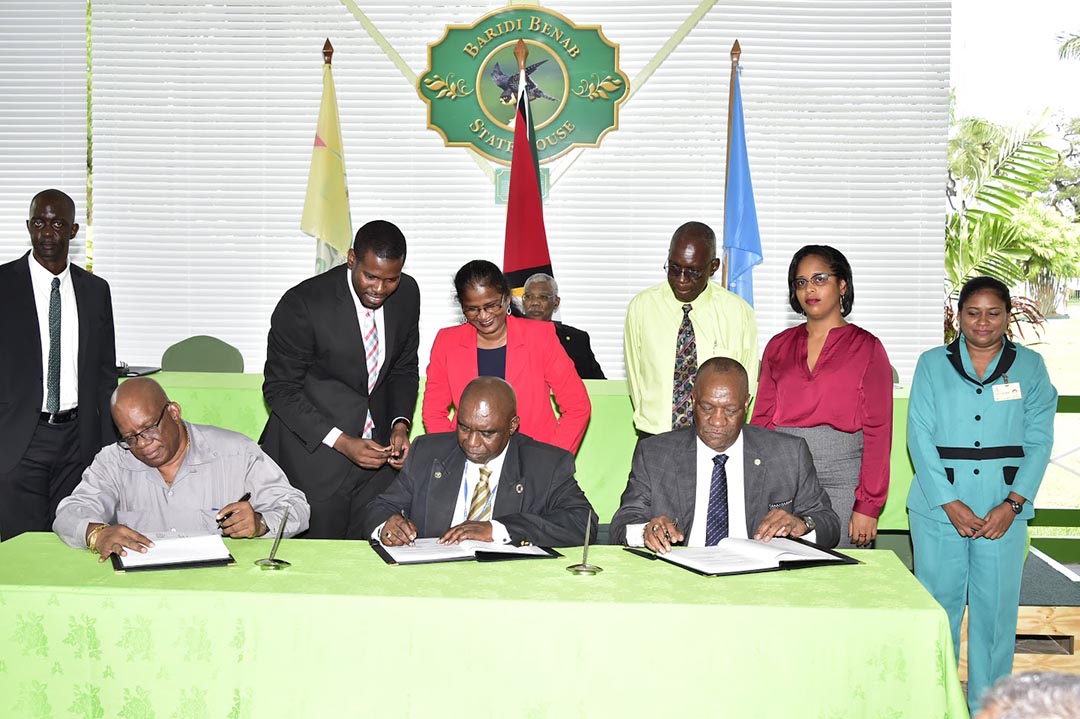The preservation of land assets is essential to the creation of a green state and a good life for future generations, President David Granger said yesterday at the launch of a US$15M Sustainable Land Development and Management Project.
It is expected among other things that conflicts and overlaps regarding land issues will be sorted out and that the Guyana Lands and Surveys Commission (GLSC) will be better able to deal with the expanding land-based development taking place country wide.
“Guyana’s land-based natural capital must be managed sustainably if present and future generations are to enjoy the ‘good life.’ Sustainable land development is essential to protecting our natural patrimony and ensuring economic development”, Granger said during a signing ceremony held at State House.
The Guyana REDD+ Investment Fund (GRIF) has committed US$14M of the $15M while the Food and Agricultural Organisation (FAO) of the United Nations has committed an additional US$100, 000 to facilitate the recruitment of consultants and to provide technical expertise within FAO to assist with the formulation of the project document.
The president noted that the reckless use and management of land can impact adversely on the environment and citizens’ quality of life.
“Guyana therefore recognizes the importance of protecting its land assets. It knows that the land degradation will result in natural resource depletion which, if not controlled, will lead to underdevelopment”, he said, while announcing that in keeping with a commitment to preserve its land assets, Guyana has agreed to place an additional two million hectares of its land under conservation and convert the Iwokrama International Centre for Rainforest Conservation and Development into a world-class biodiversity research facility.
“We shall also promote more efficient mining and logging practices, including post-extractive land reclamation; push sustainable forestry practices including reduced-impact logging and improved forest monitoring and pursue mineral mapping so to identify areas of marginal, or less than viable, mineral deposits”, he said while adding that these are steps at the international level, to which Guyana has agreed in order to protect its patrimony and provide environmental services for the rest of the world.
Guyana’s green development agenda, he said demands the fulfilment of these environmental obligations as well as the adoption of practices to better manage the land resources and the augmentation of institutional capacity to improve monitoring and verification of land use, the modernisation of archaic land development and management systems and integrated land development and management practices to resolve the problems of land degradation.
“Land governance is central to the green development agenda”, he stressed.
According to the president, the newly launched project aims at improving land governance first by promoting good evaluating capacities of state institutions concerned with land management and by preventing land conflicts; increasing land reclamation of degraded public lands and reducing degraded areas.
The project he said is therefore welcome as “it will allow Guyana to protect its natural capital by reducing land degradation and will promote responsible farming, logging, mining and other land uses”.
GLSC Commissioner, Trevor Benn in brief remarks said that the realization of the project is in keeping with the previous requests from the president that land must be seen as an economic necessity, must be made available to the landless and that the commission must work in a wholistic manner to address the appropriate land management practices.
Benn, while pointing out that the GLSC has the mandate to act as guardian of all public land in Guyana said that in recent years the country has seen an expansion of land-based investments countrywide in the areas of forestry, agriculture and mining, among others. These investments however have been plagued by a number of issues including overlapping responsibility, and conflicts, he said.
“We suffer from a lack of comprehensive baseline information to help us to make analytical decisions and we have an absence of good monitoring practices and framework for overseeing the work that we do when it comes to land”, he said while noting that as such there is a reason to rejoice with the launch of the project.
Hopefully, he said this project will significantly change the trajectory of land development and management in Guyana and is another key element in the pathway to a green economy. He said that this project will also help the GLSC to acquire the capacity to fully execute its legal mandate. Guyana to date had in excess of 34 pieces of legislation that have something to do with lands and this is causing issues which this flagship project will address, he said
The project, he said, will also address the anomalies generated by these overlapping pieces of legislation.
It is expected that out of this project the first ever land policy will be developed, there will be enhanced land governance, more regulatory and financial systems, spatial data information and management and enhance institutional capacity, Benn said.
Also delivering brief remarks were Finance Minister Winston Jordan, Marlon Bristol, Head of the Project Management Office and FAO Country Representative Reuben Robertson.
Jordan, Robertson and Minister of State Joseph Harmon later signed the document to officially launch the project.









